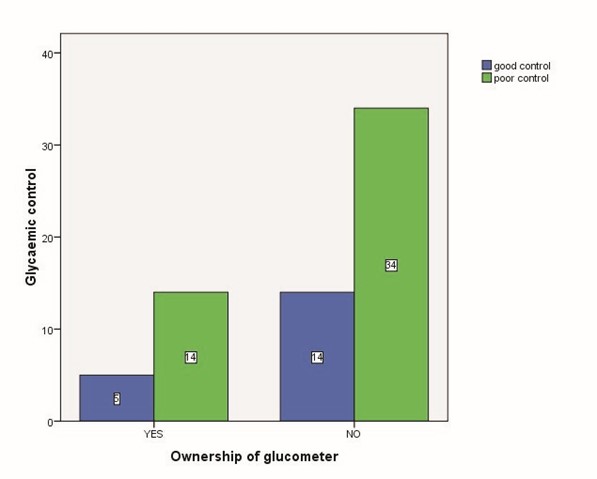Knowledge and practice of self home monitoring of blood glucose
Keywords:
Diabetes mellitus, blood glucose, self-monitoring, knowledge, practiceAbstract
Objectives: Both glycosylated haemoglobin and self-monitoring of blood glucose (SMBG) are necessary for optimal monitoring of glycaemic control in patients with diabetes mellitus. There is scanty information regarding the knowledge and practice of SMBG in Nigeria. The purpose of the study was to determine the knowledge and practice of SMBG, and its relationship with patients' demographic characteristics
Methods: A cross-sectional survey was conducted among patients attending the endocrine clinic of Ekiti State University Teaching Hospital, Ado-Ekiti. With the aid of interviewer administered questionnaire, demographic and other information on awareness of SMBG, ownership of glucometer, and practice of SMBG were obtained. The data was analysed with Statistical Package for Social Sciences (SPSS) version 16.
Results: One hundred and four patients comprising 29 males (27.9%) and 75 females (72.1%) were studied with a mean age of 59.6±13.7 years. Twenty two (21.2%) subjects had no formal education, while 38 (36.5%), 16 (15.4%), 28(26.9%) subjects had primary, secondary and tertiary education respectively. Sixty seven patients (64.4%) were aware of SMBG. Out of these, only 19 subjects (18.3%) had glucometers. Age and level of education were significantly related to ownership of glucometer (p<0.01), while income, gender, marital status and duration of diabetes were not. Only level of education predicted ownership of glucometer.
Conclusions: The awareness of SMBG was good but ownership of glucometer was poor. Age and level of education were determinants of ownership of glucometer. Only level of education predicted ownership of glucometer.
References
Diabetes Control and Complications Trial Research Group. The effect of intensive treatment of diabetes on the development and progression of long-
term complications in insulindependent diabetes mellitus. N Eng J Med. 1993;329:977-986.
UK Prospective Diabetes Study Group. Intensive blood-glucose control with sulphonylureas or insulin compared with conventional treatment and risk of complications in patients with type 2 diabetes. Lancet 1998;352:837-853.
Boutati EI, Raptis SA. Self-Monitoring of Blood Glucose as Part of the Integral Care of Type 2 Diabetes. Diabetes Care 2009;32 (Suppl. 2):S205–S210.
Adisa R, Alutundu MB, Fakeye TO. Factors contributing to non-adherence to hypoglycaemic medications among ambulatory type 2 diabetes patients in
South-western Nigeria. Pharmacy Practice (Internet).2009;7(3):163-16
Eregie A, Unadike BC. Factors associated with self-monitoring of glycaemic control among persons with diabetes in Benin City, Nigeria. Afr J Diab Med. 2011;19:13-14
Unachukwu CN, Young EE, Uchenna DI. Self-blood glucose monitoring among diabetic patients in Port Harcourt, Nigeria. Afr J Diab Med.
;19:19-20
Huri HZ, Wen OC, Pendek R. Selfmonitoring of blood glucose among type-2 diabetes patients in Malaysia. Asian Biomedicine 2008; 2(4):335-340
Yuan L, Guo X, Xiong Z, Lou Q, Shen L, Zhao F, et. al. Self-monitoring of blood glucose in type 2 diabetic patients in China: current status and influential factors. Chin Med J (Eng).2014;127(2):201-207
Oki JC, Flora DL, Isley WL. Frequency and impact of SMBG on glycemic control in patients with NIDDM in an urban teaching hospital clinic. Diabetes Educ. 1997;23(4):419-24
Karter AJ, Ferrara A, Darbinian JA,
Ackerson LM, Selby JV. SelfMonitoring of Blood Glucose:
Language and financial barriers in a managed care population with diabetes. Diabetes Care 2000; 23(4):477-483
American Diabetes Association. Clinical Practice Recommendations 1998. Diabetes Care 1998; 21(Suppl 1): S1-S98.
American Diabetes Association.
Standard of medical care in Diabetes. Diabetes Care 2014; 37(Suppl 1): S14S80.
Polonsky WH, Fisher L, Schikman CH, Hinnen DS, Parkin CG, Jelsovsky Z, et. al. Structured self-monitoring of blood glucose approach in type 2 diabetes encourages more frequent, intensive, and effective physician interventions: results from the STeP study. Diabetes Tecnol Ther. 2011;13(8):797-802.
Guerci B, Drouin P, Grange V,
Bougneres P, Fontaine P, Kerlan V, et. al. Self-monitoring of blood glucose significantly improves metabolic control in patients with type 2 diabetes: the auto-surveillance intervention active (ASIA) study. Diabetes Metab. 2003;29:587-94.
Jansen JP. Self-monitoring of glucose in type 2 diabetes mellitus: a Bayesian meta-analysis of direct and indirect comparisons. Curr Med Res Opin 2006;22:671–681
Fontbonne A, Billault B, Acosta M, Percheron C, Varenne P, Besse A, et. al. Is glucose self-monitoring beneficial in non–insulin-treated diabetic patients? Results of a randomized comparative trial. Diabete Metab 1989;15:255–260
Davidson MB, Castellanos M, Kain D, Duran P. The effect of self-monitoring of blood glucose concentrations on glycated hemoglobin levels in diabetic patients not taking insulin: a blinded, randomized trial. Am J Med
;118:422–425
International Diabetes Federation. Guideline on self-monitoring of blood glucose in noninsulin treated type 2 d i a b e t e s . A v a i l a b l e a t :
http://www.idf.org/webdata/docs/SM BG_EN2.pdf. Accessed on 5 May 2014.

Downloads
Published
How to Cite
Issue
Section
License
Copyright (c) 2023 Research Journal of Health Sciences

This work is licensed under a Creative Commons Attribution-NonCommercial-NoDerivatives 4.0 International License.
Research Journal of Health Sciences journal is a peer reviewed, Open Access journal. The Journal subscribed to terms and conditions of Open Access publication. Articles are distributed under the terms of Creative Commons License (CC BY-NC-ND 4.0). (http://creativecommons.org/licences/by-nc-nd/4.0). All articles are made freely accessible for everyone to read, download, copy and distribute as long as appropriate credit is given and the new creations are licensed under the identical terms.

